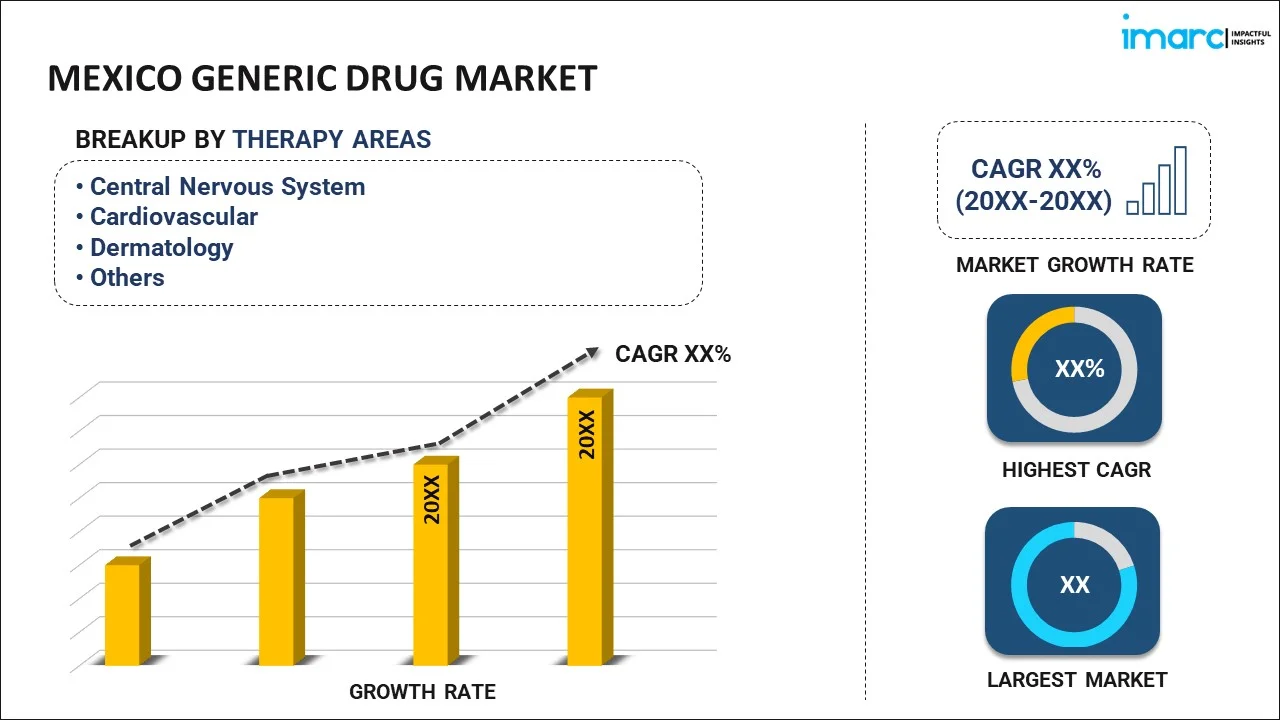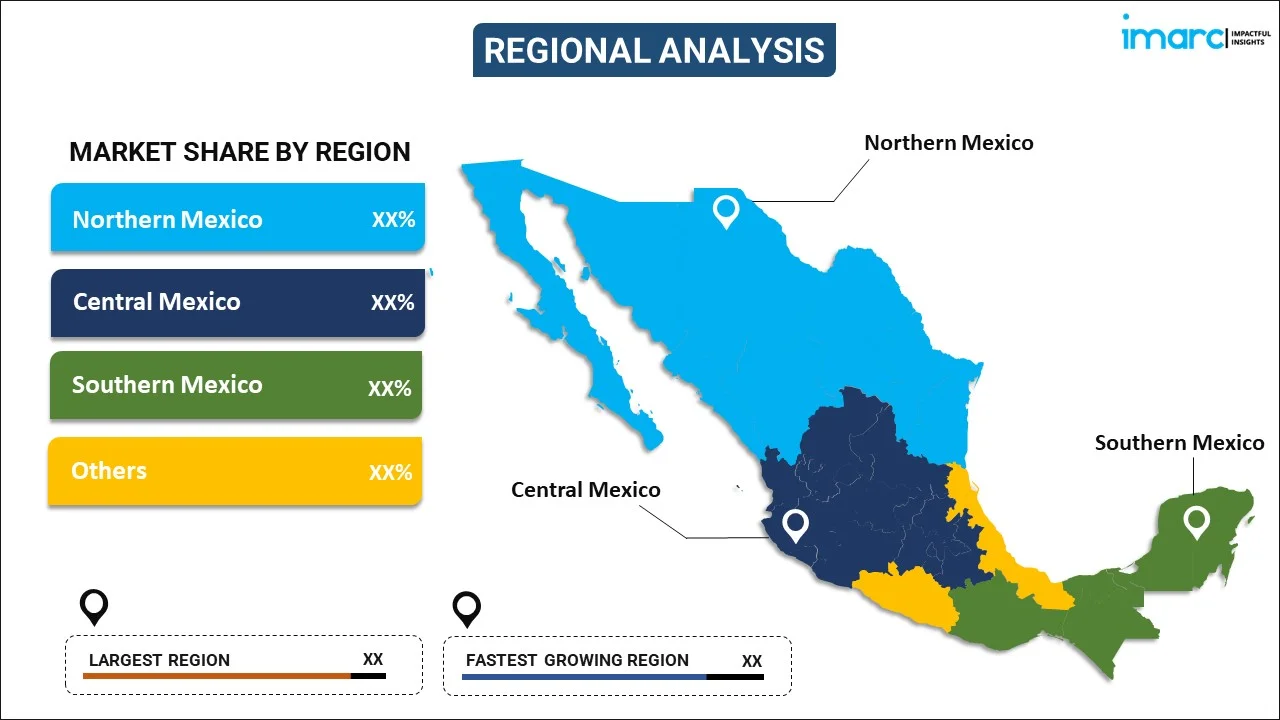
Mexico Generic Drug Market Report by Therapy Area (Central Nervous System, Cardiovascular, Dermatology, Genitourinary/Hormonal, Respiratory, Rheumatology, Diabetes, Oncology, and Others), Drug Delivery (Oral, Injectables, Dermal/Topical, Inhalers), Distribution Channel (Retail Pharmacies, Hospital Pharmacies), and Region 2025-2033
Market Overview:
Mexico generic drug market size reached USD 7.4 Billion in 2024. Looking forward, IMARC Group expects the market to reach USD 12.1 Billion by 2033, exhibiting a growth rate (CAGR) of 5.25% during 2025-2033. The implementation of favorable policies and initiatives aimed at promoting the use of generic drugs, the expanding pharmaceutical industry, and the increasing prevalence of chronic diseases represent some of the key factors driving the market.
|
Report Attribute
|
Key Statistics
|
|---|---|
|
Base Year
|
2024 |
|
Forecast Years
|
2025-2033
|
|
Historical Years
|
2019-2024
|
| Market Size in 2024 | USD 7.4 Billion |
| Market Forecast in 2033 | USD 12.1 Billion |
| Market Growth Rate (2025-2033) | 5.25% |
A generic drug is a medication that is equivalent to a brand-name or innovator drug in terms of its active pharmaceutical ingredient, dosage form, strength, route of administration, and intended use. Generic drugs are essentially copies of brand-name drugs and are typically marketed under their chemical or generic names rather than a brand name. One of the primary advantages of generic drugs is their lower cost. Since generic drug manufacturers do not need to invest in extensive research and development or marketing, they can offer their products at a significantly lower price compared to brand-name drugs. These drugs are rigorously tested and approved by regulatory authorities, such as the U.S. Food and Drug Administration (FDA) in the United States or the European Medicines Agency (EMA) in Europe, to ensure their safety, quality, and effectiveness. They are often sold in packaging and labeled with their generic name, which can be different from the brand name. However, the active ingredient(s) and strength are prominently displayed.
Mexico Generic Drug Market Trends:
One of the primary drivers of the Mexican generic drug market is the cost-effectiveness of generic medications. Generic drugs are typically more affordable than their brand-name counterparts, making them an attractive option for patients and healthcare providers. In a country where healthcare expenses can be a significant burden for many, the lower cost of generics is a compelling factor. In addition, the Mexican government has implemented policies and initiatives aimed at promoting the use of generic drugs. These efforts include regulatory incentives, price controls, and programs to encourage the prescription and use of generics in public healthcare facilities. Government support plays a crucial role in driving the adoption of generic medications. Besides, the overall healthcare expenditure in Mexico has been increasing, partly due to the aging population and the growing burden of chronic diseases. Generic drugs offer a way to manage healthcare costs without compromising on the quality of treatment. Moreover, healthcare professionals in Mexico are becoming more accepting of generic medications, recognizing their safety, efficacy, and cost benefits. This shift in attitude has led to a higher rate of generic drug prescription. Additionally, patients are becoming more aware of generic options and are often open to using them as a more cost-effective way to manage their health conditions. This awareness has contributed to the growing demand for generic drugs. Furthermore, the pharmaceutical industry in Mexico is expanding, including the production of generic medications. This growth leads to a broader range of available generic drugs and increased competition among manufacturers.
Mexico Generic Drug Market Segmentation:
IMARC Group provides an analysis of the key trends in each segment of the market, along with forecasts at the country level for 2025-2033. Our report has categorized the market based on therapy area, drug delivery, and distribution channel.
Therapy Area Insights:

- Central Nervous System
- Cardiovascular
- Dermatology
- Genitourinary/Hormonal
- Respiratory
- Rheumatology
- Diabetes
- Oncology
- Others
The report has provided a detailed breakup and analysis of the market based on the therapy area.. This includes central nervous system, cardiovascular, dermatology, genitourinary/hormonal, respiratory, rheumatology, diabetes, oncology, and others.
Drug Delivery Insights:
- Oral
- Injectables
- Dermal/Topical
- Inhalers
A detailed breakup and analysis of the market based on the drug delivery have also been provided in the report. This includes oral, injectables, dermal/topical, and inhalers.
Distribution Channel Insights:
- Retail Pharmacies
- Hospital Pharmacies
The report has provided a detailed breakup and analysis of the market based on the distribution channel. This includes retail pharmacies and hospital pharmacies.
Regional Insights:

- Northern Mexico
- Central Mexico
- Southern Mexico
- Others
The report has also provided a comprehensive analysis of all the major regional markets, which include Northern Mexico, Central Mexico, Southern Mexico, and Others.
Competitive Landscape:
The market research report has also provided a comprehensive analysis of the competitive landscape in the market. Competitive analysis such as market structure, key player positioning, top winning strategies, competitive dashboard, and company evaluation quadrant has been covered in the report. Also, detailed profiles of all major companies have been provided.
Mexico Generic Drug Market Report Coverage:
| Report Features | Details |
|---|---|
| Base Year of the Analysis | 2024 |
| Historical Period | 2019-2024 |
| Forecast Period | 2025-2033 |
| Units | Billion USD |
| Scope of the Report | Exploration of Historical Trends and Market Outlook, Industry Catalysts and Challenges, Segment-Wise Historical and Future Market Assessment:
|
| Therapy Areas Covered | Central Nervous System, Cardiovascular, Dermatology, Genitourinary/Hormonal, Respiratory, Rheumatology, Diabetes, Oncology, Others |
| Drug Deliveries Covered | Oral, Injectables, Dermal/Topical, Inhalers |
| Distribution Channels Covered | Retail Pharmacies, Hospital Pharmacies |
| Regions Covered | Northern Mexico, Central Mexico, Southern Mexico, Others |
| Customization Scope | 10% Free Customization |
| Post-Sale Analyst Support | 10-12 Weeks |
| Delivery Format | PDF and Excel through Email (We can also provide the editable version of the report in PPT/Word format on special request) |
Key Questions Answered in This Report:
- How has the Mexico generic drug market performed so far and how will it perform in the coming years?
- What has been the impact of COVID-19 on the Mexico generic drug market?
- What is the breakup of the Mexico generic drug market on the basis of therapy area?
- What is the breakup of the Mexico generic drug market on the basis of drug delivery?
- What is the breakup of the Mexico generic drug market on the basis of distribution channel?
- What are the various stages in the value chain of the Mexico generic drug market?
- What are the key driving factors and challenges in the Mexico generic drug?
- What is the structure of the Mexico generic drug market and who are the key players?
- What is the degree of competition in the Mexico generic drug market?
Key Benefits for Stakeholders:
- IMARC’s industry report offers a comprehensive quantitative analysis of various market segments, historical and current market trends, market forecasts, and dynamics of the Mexico generic drug market from 2019-2033.
- The research report provides the latest information on the market drivers, challenges, and opportunities in the Mexico generic drug market.
- Porter's five forces analysis assist stakeholders in assessing the impact of new entrants, competitive rivalry, supplier power, buyer power, and the threat of substitution. It helps stakeholders to analyze the level of competition within the Mexico generic drug industry and its attractiveness.
- Competitive landscape allows stakeholders to understand their competitive environment and provides an insight into the current positions of key players in the market.
Need more help?
- Speak to our experienced analysts for insights on the current market scenarios.
- Include additional segments and countries to customize the report as per your requirement.
- Gain an unparalleled competitive advantage in your domain by understanding how to utilize the report and positively impacting your operations and revenue.
- For further assistance, please connect with our analysts.
 Inquire Before Buying
Inquire Before Buying
 Speak to an Analyst
Speak to an Analyst
 Request Brochure
Request Brochure
 Request Customization
Request Customization




.webp)




.webp)












